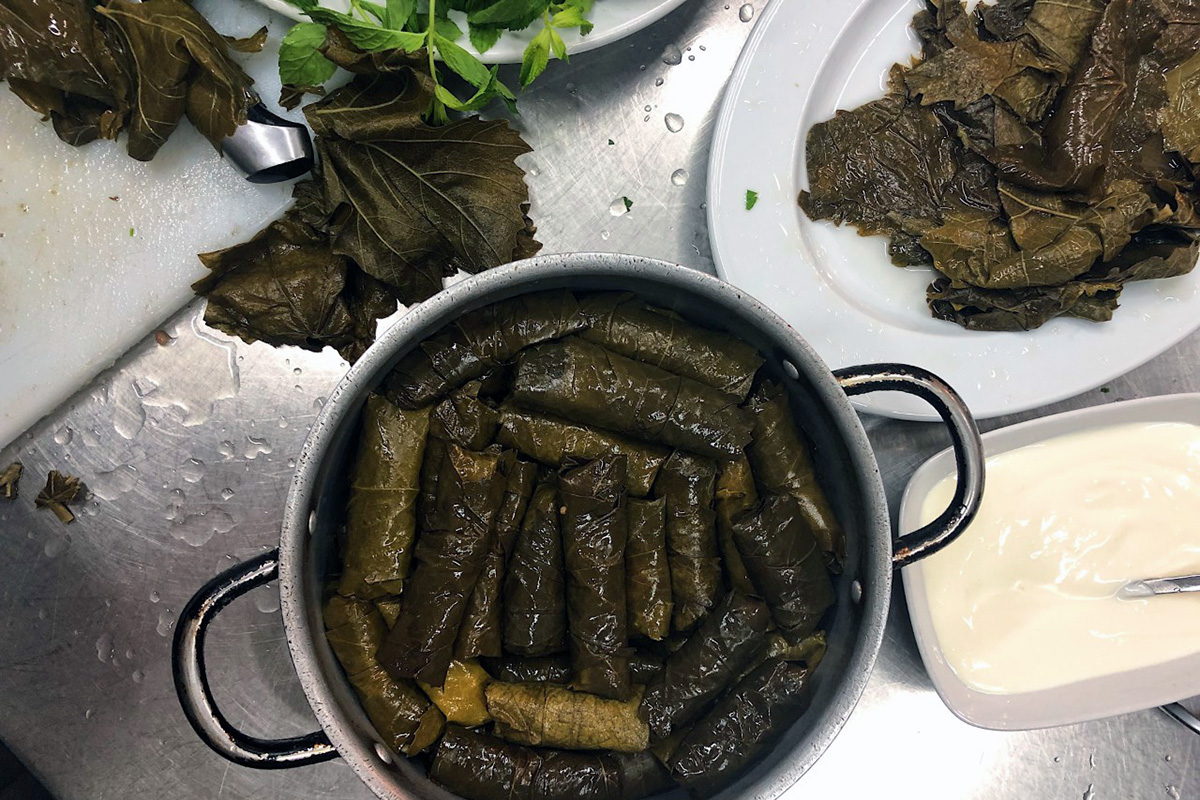Through the Edible Grapevine: Stories of Yalanchi in Armenian Communities

Photo by Mara Hoplamazian
I didn’t like yalanchi as a kid. The stuffed grape leaves were a staple on the Thanksgiving tables of my childhood, one that went generally forsaken by my siblings in favor of the heaping bowl of Armenian string cheese seasoned with nigella seeds and mahleb, a spice made from the crushed pits of St. Lucie cherries with a smell that stayed heavy on my clothes and in my memory. But in July 2018, when my family visited the Smithsonian Folklife Festival, I spotted a tent that was set up to record memories of Armenian food and immediately thought of deep green yalanchi, shining in their hills on my grandmother’s dining room table.
Yalanchi are as beloved as they are difficult to make. A commenter on a food blog I recently ventured to wrote, “I could sleep in a king-sized bed lined fully with yalanchi, that’s how much I love it.” It’s a food that demands dedication, requiring hours of picking leaves, preparing rice, chopping parsley and mint, crying over diced onions, and rolling each piece into a perfectly sized bite. If you’re lucky, there are many pairs of hands involved and good conversations to pass the time.
This summer, I’ve been digging into the archive of oral histories that were recorded at the 2018 Festival, in the tent I spotted on that sunny afternoon. Yalanchi is mentioned in nearly every interview. Ken Maranian remembered the grape vines in his neighborhood in Boston and how picking leaves instead of grapes set his family apart from their neighbors. Carolyn Rapkievian recalled her husband, who is not Armenian but participates in many Armenian cultural events, learning to roll yalanchi around a table with the women of St. Mary’s Armenian Church in Washington, D.C. Jane Karakashian reminisced about the time her affinity for yalanchi followed her to France, and she took advantage of the grape vines growing across the buildings to roll some appetizers for her aunt and uncle.

At the Festival, a few tents away from the Food Memories recording booth, Levon Avdoyan and Noubar Afeyan spoke on a panel called “Cultures of Survival: Armenians in America.” They discussed the ways that each Armenian community in the United States has unique ways of bringing Armenian traditions into their lives. Throughout the oral histories of Armenian food, it is clear that each of these communities has a different way of preserving their culture—and rolling their yalanchi.
The food memories span generations and continents of Armenians’ experiences in diaspora. The stuffed grape leaves that each of us remember so fondly even go by different names: dolma, dolmeh, dolmedes, tolma, yerba, yaprakh, sarma, or yalanchi, depending on where they are made and which ingredients are rolled into them. Some use cinnamon and currants, others use parsley and mint. These names and spices reflect the cultures and languages of the places Armenians were historically displaced to: Syria, Iran, and Lebanon, among many others. Jane Karakashian explained that the name her family uses, sarma, is Turkish, because her grandparents weren’t allowed to speak Armenian while they were growing up. Yalanchi, too, is a Turkish word. It means “liar”—a reference to the lack of meat in the cold, vegetarian version that I grew up eating.
Grape leaves hold together a mix of ingredients that conjure memories, bringing people together though the spices are different from table to table. The stories and skills passed around while rolling yalanchi carry history and culture across Armenian communities in the diaspora, each figuring out how to sustain their particular traditions.
My childhood distaste for yalanchi has been replaced by an adult obsession. Each time I pick one up from my grandmother’s table, or from the Stop & Shop salad bar takeaway container, I think of the hands that rolled it and the generations of knowledge that they hold.
While rolling the yalanchi from the recipe below, listen to Ken, Carolyn, and Jane’s memories.

Recipe: Yalanchi, or Grape Leaves Stuffed with Rice
Makes 30 pieces
Ingredients
2 cups long grain white rice
10 walnuts
2-3 tablespoons sweet pomegranate juice
2-3 tablespoons tomato paste
2-3 tablespoons red pepper powder
20 stems parsley
20 stems mint
3/4 cup olive oil
1 white onion
1 lemon
1 pound preserved grape leaves
Salt and pepper to taste


Preparation
Parboil rice for 10 minutes.
Dice the onion very small and saute until soft. Chop parsley and mint. Mix all ingredients except for grape leaves in a large mixing bowl.
Wrap rice mixture in grape leaves. To roll, add a large spoonful of the mixture to the center of one grape leaf. Fold in the sides of the leaves from right and left and then roll from the bottom to the top, similar to wrapping a burrito.
Place wrapped grape leaves in a large pot with 1 liter of water. Cook for 20 minutes with a plate on top to keep the yalanchi submerged.
Carefully take out of pot, making sure they do not unravel.
Place in a circle to be served. Garnish with lemon slices, garlic yogurt, mint, parsley, or olive oil.
Mara Hoplamazian is a media intern at the Center for Folklife and Cultural Heritage. She is pursuing a bachelor of arts in American studies at Yale University. This summer she ordered a five-ounce jar of mahleb online and has baked nearly all of it into choreg.

